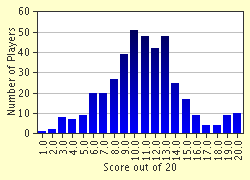Quiz Answer Key and Fun Facts
1. The Roman Catholic Church held nine 'Church Councils' between 1215 and 1545 to deal with what issue?
2. Martin Luther is credited as being the person who began the Reformation in the 16th Century by doing what action?
3. Where was Luther supposed to stand trial and answer for the action that he perpetrated which in effect began the Reformation?
4. Which of the following people began an independent reform movement that was NOT an offshoot of Lutheranism?
5. Where was Martin Luther born?
6. Before splitting from (well, okay, being excommunicated from ...) the Catholic Church, to what monastic Order did Luther belong?
7. St. Ignatius Loyola, was the founder of what religious order that fought most tenaciously for Roman Catholicism in debates at the very beginning of the Reformation?
8. One of the key tenets of Roman Catholicism that Luther rejected was the Doctrine of Transubstantiation. What did this Doctrine mean?
9. What religious sect broke away from Zwinglism insisting that the principle of scriptural authority should be applied without compromise, unlike most other forms of Protestantism that emerged throughout the Reformation?
10. What was the Schmalkald League?
11. What was the name that French Protestants adopted?
12. What effectively ended the Schmalkald League in 1555?
13. Who was the Pope when Luther began the split from traditional Roman Catholicism?
14. Which king used the Reformation as a convenient excuse to marry the way he wanted to?
15. Which very influential family was the power behind the throne at the time that the Reformation began gaining ground in France?
16. During the French struggles between Catholicism and Protestantism, what bloody massacre set off a string of small wars?
17. After ten years of war following the Massacre in Question 16, the French King's mother attempted to reconcile the Catholics and Protestants by what means?
18. Following the French King's mother's failed attempt at reconciling France's warring factions, what event sparked the next ferocious round of civil war?
19. What series of wars erupted in Germany in 1524 and 1525 as the result of Injustice and also the teachings of Luther and Zwingli, that resulted in a angry written treatise by Luther?
20. What invention that appeared in Europe shortly before the outset of the Reformation is credited as having played a key role in the spread of Protestantism?
Source: Author
TemplarLLM
This quiz was reviewed by FunTrivia editor
bloomsby before going online.
Any errors found in FunTrivia content are routinely corrected through our feedback system.

